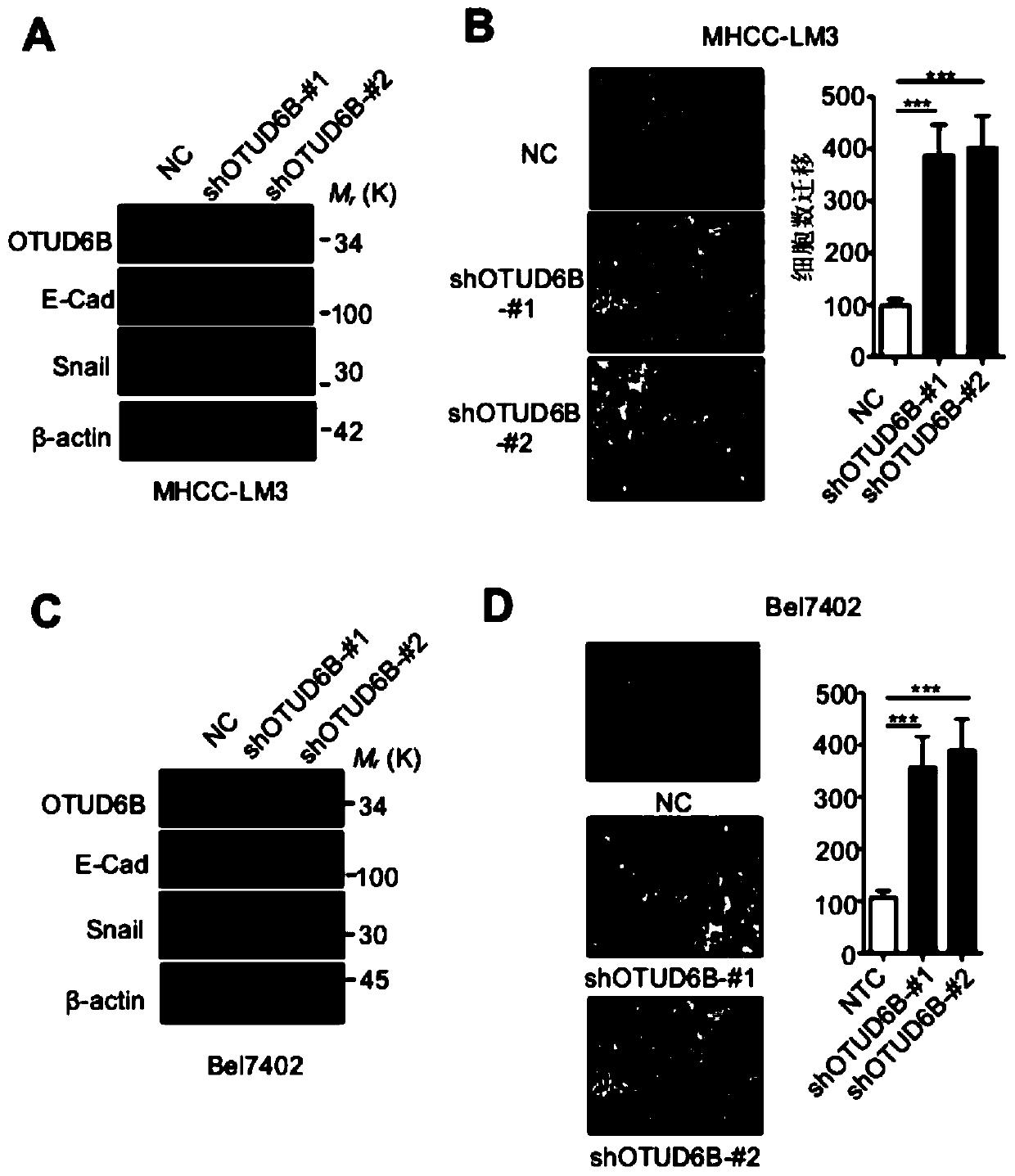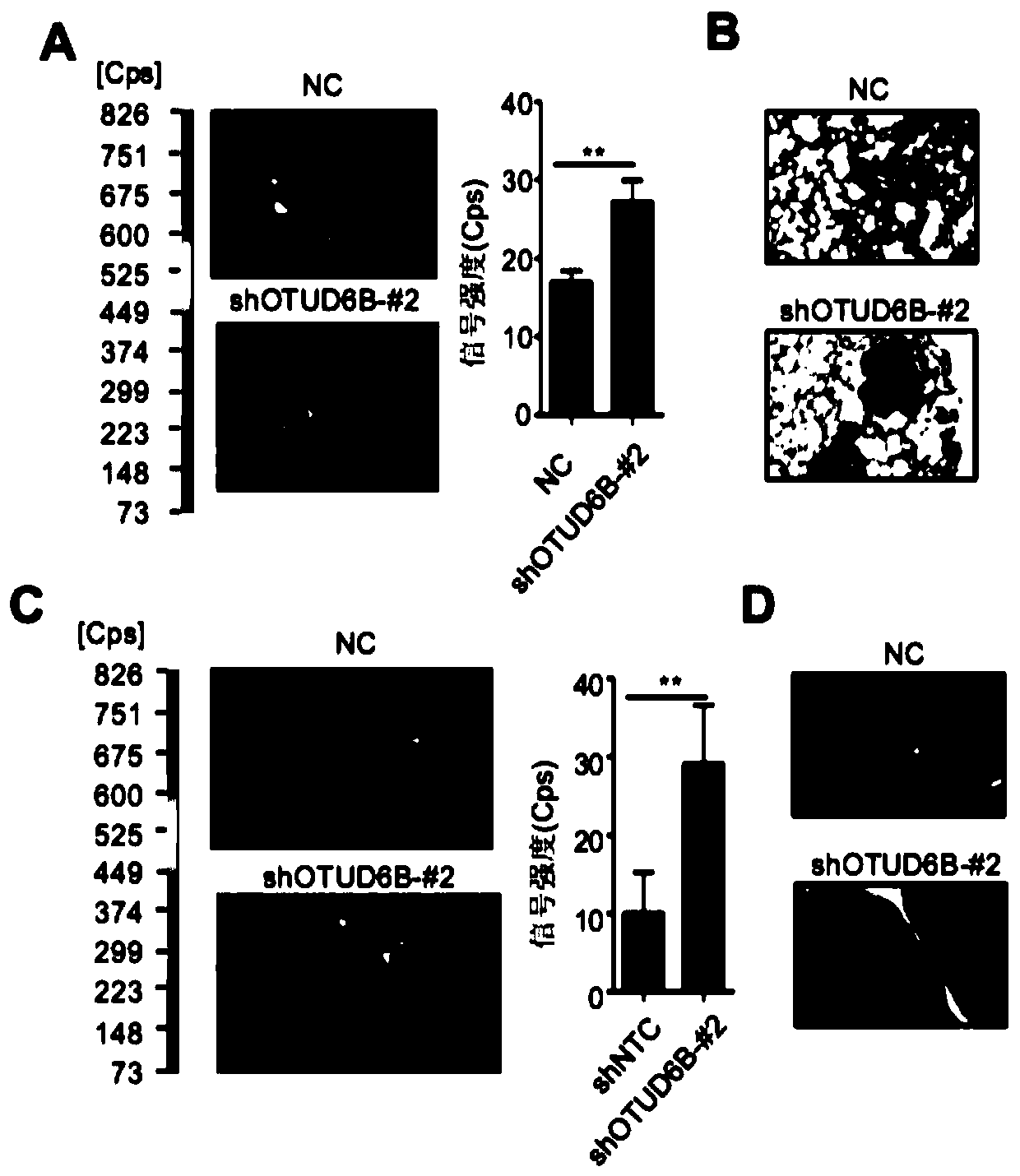Novel hypoxia signal regulation molecule and application thereof
A technology of hypoxia-inducible factor and signal, applied in the field of biomedicine, can solve the problems of hypoxia, uncontrolled growth, insufficient oxygen in the area of liver cancer tissue, etc.
- Summary
- Abstract
- Description
- Claims
- Application Information
AI Technical Summary
Problems solved by technology
Method used
Image
Examples
Embodiment 1
[0183] Example 1, OTUD6B inhibits the metastasis of liver cancer cells
[0184] 1. OTUD6B inhibits the migration of liver cancer cells in vitro
[0185] 1. Construction of MHCC-LM3 cells knocking down OTUD6B and Bel-7402 cells knocking down OTUD6B.
[0186] 2. Western Blot detection of knockdown efficiency and expression of cell migration-related protein markers (E-Cadhenrin, Snail) (anti-E-Cadhenrin antibody and anti-Snail antibody are both products of Santa Cruz Company).
[0187] See the test results figure 1 . The results showed that both targeting shRNA sequences had high knockdown efficiency.
[0188] 3. Cell migration experiments were performed using Transwell assay.
[0189] see results figure 1 . The results showed that the downregulation of OTUD6B significantly promoted the migratory ability of MHCC-LM3 cells compared with the non-targeted knockdown sequence; the migratory ability of Bel-7402 cells was also significantly enhanced after knockdown of OTUD6B.
[...
Embodiment 2
[0205] Example 2, OTUD6B is a hypoxia signal regulation molecule
[0206] 1. RNA-Seq analysis
[0207] RNA was extracted from OTUD6B-knockdown MHCC-LM3 cells and MHCC-LM3 cells, and transcriptome sequencing was performed to analyze the expression of differential genes.
[0208] Some sequencing results are shown in Table 5. The results showed that among the genes upregulated in MHCC-LM3 cells knocking down OTUD6B, many genes were related to cell migration. Further bioinformatics analysis found that 80% of the genes (such as DCN, NOS2DUSP6, etc.) could be enriched in the HIF signaling pathway .
[0209] table 5
[0210]
[0211]
[0212] Note: N means no, Y means yes.
[0213] 2. OTUD6B inhibits the expression of HIF downstream target genes
[0214] Vascular endothelial growth factor (VEGF) is a target gene of HIF. It binds to the ligand VEGFR to activate the downstream signal pathway regulating angiogenesis and promote the metastasis of cancer cells. MMP2 gene and L...
Embodiment 3
[0233] Example 3, OTUD6B affects the migration of liver cancer cells by regulating the VHL-HIF pathway
[0234] 1. OTUD6B stabilizes VHL protein levels
[0235] OTUD6B can regulate the protein levels of HIF-1α and HIF-2α without significant changes in their mRNA expression levels. This result suggests that the regulation of HIF by OTUD6B may be through protein post-translational modification pathways. Therefore, it is speculated that OTUD6B regulates its stability by regulating its ubiquitination process. If OTUD6B is the ubiquitination modification of HIF, it should play a positive regulatory role in its stability, but after knocking down OTUD6B, the protein levels of HIF-1α and HIF-2α are up-regulated, so it is speculated that OTUD6B may regulate HIF-1α The stability of the E3 ubiquitin ligase of HIF-2α and HIF-2α in turn regulates its protein level.
[0236] VHL is a tumor suppressor protein, and its main function is to degrade HIF-1α and HIF-2α by ubiquitination as E3. ...
PUM
 Login to View More
Login to View More Abstract
Description
Claims
Application Information
 Login to View More
Login to View More - R&D
- Intellectual Property
- Life Sciences
- Materials
- Tech Scout
- Unparalleled Data Quality
- Higher Quality Content
- 60% Fewer Hallucinations
Browse by: Latest US Patents, China's latest patents, Technical Efficacy Thesaurus, Application Domain, Technology Topic, Popular Technical Reports.
© 2025 PatSnap. All rights reserved.Legal|Privacy policy|Modern Slavery Act Transparency Statement|Sitemap|About US| Contact US: help@patsnap.com



